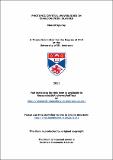Photonic crystal waveguides in chalcogenide glasses
Abstract
The growing speed and bandwidth requirements of telecommunication systems
demand all-optical on-chip solutions. Microphotonic devices can deliver
low power nonlinear signal processing solutions. This thesis looks at the slow
light photonic crystals in chalcogenide glasses to enhance low power nonlinear
operation.
I demonstrate the development of new fabrication techniques for this delicate
class of materials. Both, reactive ion etching and chemically assisted ion
beam etching are investigated for high quality photonic crystal fabrication.
A new resist-removal technique was developed for the chemical, mechanical
and light sensitive thin films.
I have developed a membraning method based on vapor phase etching
in combination with the development of a save and economical etching tool
that can be used for a variety of vapour phase processes.
Dispersion engineered slow light photonic crystals in Ge₃₃As₁₂Se₅₅ are designed
and fabricated. The demonstration of low losses down to 21±8dB/cm
is a prerequisite for the successful demonstration of dispersion engineered
slow light waveguides up to a group index of around n[subscript(g)] ≈ 40.
The slow light waveguides are used to demonstrate highly efficient third
harmonic generation and the first advantages of a pure chalcogenide system
over the commonly used silicon. Ge₁₁.₅As₂₄24Se₆₄.₅ is used for the fabrication
of photonic crystal cavities. Quality factors of up to 13000 are demonstrated.
The low nonlinear losses have enabled the demonstration of second and third
harmonic generation in those cavities with powers up to twice as high as
possible in silicon.
A computationally efficient model for designing coupled resonator bandpass
filters is used to design bandpass filters. Single ring resonators are
fabricated using a novel method to define the circular shape of the rings to
improve the fabrication quality. The spectral responses of the ring resonators
are used to determine the coupling coefficient needed for the design and fabrication
of the bandpass filters. A flat top bandpass filter is fabricated and
characterized as demonstration of this method.
A passive all-optical regenerator is proposed, by integrating a slow-light
photonic crystal waveguide with a band-pass filter based on coupled ring
resonators. A route of designing the regenerator is proposed by first using
the dispersion engineering results for nonlinear pulse propagation and then
using the filter responses to calculate the nonlinear transfer function.
Type
Thesis, PhD Doctor of Philosophy
Rights
Creative Commons Attribution-NonCommercial-NoDerivs 3.0 Unported
http://creativecommons.org/licenses/by-nc-nd/3.0/
Collections
Except where otherwise noted within the work, this item's licence for re-use is described as Creative Commons Attribution-NonCommercial-NoDerivs 3.0 Unported
Items in the St Andrews Research Repository are protected by copyright, with all rights reserved, unless otherwise indicated.


